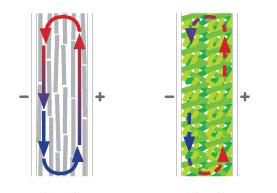
Warmth
Your house needs to have warmth, but the right kind. Ekovilla warmth is the wholeness created by a warm living space and a good living environment.
The most important job of thermal insulation is to keep warmth inside the house even in the frostiest of frosts and keep the inside of your house cool in summer heat. Maintaining indoor temperature relates to heat transfer properties (like thermal conductivity) of a material, to its ability to bind air and prevent air movement and its reaction to humidity.
Quality insulation will keep your house suitably warm, nicely breathable and helps to lower the heating bill.
Heat is transferred from the outside through the insulation structure in three main ways:
by conduction along the insulation material (lambda value)
by radiation
by moving along the air currents inside the insulation (convection), or along the air leaks (construction defect) occurring through the insulation structure.
The thermal conductivity (lambda value) of thermal insulation describes how little the insulation conducts heat. The actual air-binding capacity of the insulation has not been taken account in these theoretical values, but it strongly effects the actual thermal insulation capacity. The better the air remains inside the insulation, the better the thermal insulation capacity of a material and the superb insulation capacity of Ekovilla is based on this very property.
See the detailed features of our products.

The most effective thermal insulation solutions come from nature. Creatures living in cold conditions are especially well adapted to extreme cold – their guard hairs are hollow, containing plenty of insulating air. Between guard hairs they also have furry down hair which prevent air from moving inside the coat. Ekovilla offers the same superbly natural kind of warmth for your home.
The material of Ekovilla insulation is natural wood fiber. Inside the fibers are cells – these contain pockets of air and keep the air still, forming a very effective thermal insulation. There is also plenty of insulating air between the Ekovilla fibers, this is achieved by milling the fibers in a special way during the manufacturing stage. This way the fibers become short, fluffy and interlocking, forming a loose thermal insulation which locks the air inside.
The forming air pockets are very small, which prevents any unwanted airflow inside them. Regardless of installation method (blowing, spraying or insulation slab), Ekovilla has minimal air permeability which is an important feature, especially in wall structures.
The temperature difference between the sides of insulation causes airflow (convection) inside the insulation material. The warm air on the inside tends to rise and the cold air on the outside tends to fall. The denser and fluffier the fibrous material storing the air, the smaller the cooling effect on the structure.



